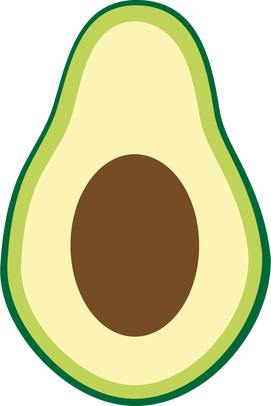Lila Avocado
Lila Avocado trees are wonderful as container plants indoors and on patios. The tree only reaches a maximum height of about 5 feet indoors, or 10 to 15 feet outside. Just because the tree is small, does not mean the flavor of its fruit is too! Lila Avocados bear rich tasting, nutty flavored fruit with high-oil content, weighing 6 to 8 ounces.
- Full sun
- Water when planted and every other day during the first week. Trees should be watered 1-2 times per week for the first 3 years. Once established, water during dry periods that last at least 5 days without rainfall.
- USDA Zone: 8-11
Water and Soil
Avocado trees do not handle waterlogged, non-draining soils well. Too much water around the base of the tree can result in reduced yields, decreased growth rates, signs of nutrient deficiencies, and even death. Make sure your avocado tree is not in a flooded location in your kingdom. If the area you have chosen to plant your tree has a habit of collecting too much water, choose another location or create a tall soil mound (2-4 feet tall and 4-6 feet diameter) to elevate your tree above the water. Preferably, choose well-draining soils. In the first year in Florida, avocado trees should be fertilized every 1 to 2 months. After year 1, they should be fertilized about 3 to 4 times per year.
Planting and Pruning
When choosing where to plant your avocado tree, choose a location in full sun away from buildings, other trees, or other structures. Remember that avocado trees are trees; they can grow very tall if they are not pruned. We recommend keeping your avocado trees about 20 feet tall to keep harvesting easy! If you are planting more than one avocado tree, space them at least 20 feet apart. Too much shade from other trees and structures will reduce your tree's growth and fruit yield.
Flower Types
There are two types of avocado flowers: A and B. Avocados are self-fertile, as they have both female and male flowers. The difference between type A and type B is the time in which their male and female flowers are active. Flower Type A's female flowers are active in the morning and the male flowers are active in the afternoon. Flower Type B's female flowers are active in the afternoon and the male flowers are active in the morning. When both type A and type B are planted near each other, the fruit yield increases!
Avocado trees do not handle waterlogged, non-draining soils well. Too much water around the base of the tree can result in reduced yields, decreased growth rates, signs of nutrient deficiencies, and even death. Make sure your avocado tree is not in a flooded location in your kingdom. If the area you have chosen to plant your tree has a habit of collecting too much water, choose another location or create a tall soil mound (2-4 feet tall and 4-6 feet diameter) to elevate your tree above the water. Preferably, choose well-draining soils. In the first year in Florida, avocado trees should be fertilized every 1 to 2 months. After year 1, they should be fertilized about 3 to 4 times per year.
Planting and Pruning
When choosing where to plant your avocado tree, choose a location in full sun away from buildings, other trees, or other structures. Remember that avocado trees are trees; they can grow very tall if they are not pruned. We recommend keeping your avocado trees about 20 feet tall to keep harvesting easy! If you are planting more than one avocado tree, space them at least 20 feet apart. Too much shade from other trees and structures will reduce your tree's growth and fruit yield.
Flower Types
There are two types of avocado flowers: A and B. Avocados are self-fertile, as they have both female and male flowers. The difference between type A and type B is the time in which their male and female flowers are active. Flower Type A's female flowers are active in the morning and the male flowers are active in the afternoon. Flower Type B's female flowers are active in the afternoon and the male flowers are active in the morning. When both type A and type B are planted near each other, the fruit yield increases!




